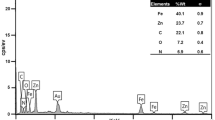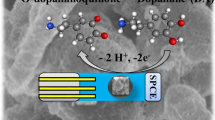Abstract
Fe3O4 magnetic nanoparticles (MNPs) and Fe3O4-deposited multi-walled carbon nanotubes (Fe3O4@MWCNTs) were synthesized by ultrasonic co-precipitation method. The surface and structural properties of Fe3O4 MNPs and Fe3O4@MWCNTs were characterized by X-ray diffraction, field emission transmission electron microscopy (FE-TEM), X-ray photoelectron spectroscopy, and dynamic light scattering (DLS). Sedimentation field-flow fractionation (SdFFF) was, for the first time, employed to study the influence of synthesis parameters on size distribution of Fe3O4 MNPs. A reasonable resolution for SdFFF analysis of Fe3O4 MNPs was obtained by a combination of 1,600 RPM, flow rate of 0.3 mL min−1, and Triton X-100. The results suggest that lower pH and higher reaction temperature tend to yield smaller Fe3O4 MNPs size. The size distribution of Fe3O4 MNPs obtained from SdFFF was compared with those obtained from TEM and DLS. Also the effect of the particle size of Fe3O4 MNPs on electrochemical property of Fe3O4@MWCNTs-treated screen printed electrode (SPE) was studied. Cyclic voltammetry revealed that SPE treated with MWCNTs yields a significantly enhanced signal than that with no treatment. The SPE signal was even further enhanced with addition of Fe3O4 MNPs. For SPE analysis of dopamine, a liner range of 0.005–0.1 mM with a correlation coefficient of 0.986 was observed. Results revealed that (1) SdFFF is a useful tool for size-based separation and characterization of MNPs; (2) Proposed methods for synthesis of Fe3O4 nanoparticles and Fe3O4@MWCNTs are mild and fast (about 30 min); (3) SPE treated with Fe3O4@MWCNTs shows potential applicability for biosensing.









Similar content being viewed by others
References
Andersson M, Fromell K, Gullberg E, Artursson P, Caldwell KD (2005) Characterization of surface-modified nanoparticles for in vivo biointeraction: a sedimentation field flow fractionation study. Anal Chem 77:5488–5493
Baalousha M, Lead JR (2007) Characterization of natural aquatic colloids (<5 nm) by flow-field flow fractionation and atomic force microscopy. Environ Sci Technol 41:1111–1117
Baalousha M, Lead JR (2012) Rationalizing nanomaterial sizes measured by atomic force microscopy, flow field-flow fractionation, and dynamic light scattering: sample preparation, polydispersity, and particle structure. Environ Sci Technol 46:6134–6142
Bi Y, Pan X, Chen L, Wan QH (2011) Field-flow fractionation of magnetic particles in a cyclic magnetic field. J Chromatogr A 1218:3908–3914
Contado C, Argazzi R (2009) Size sorting of citrate reduced gold nanoparticles by sedimentation field-flow fractionation. J Chromatogr A 1216:9088–9098
Contado C, Argazzi R (2011) Sedimentation field flow fractionation and flow field flow fractionation as tools for studying the aging effects of WO3 colloids for photoelectrochemical uses. J Chromatogr A 1218:4179–4187
Dieckmann Y, Cölfen H, Hofmann H, Petri-Fink A (2009) Particle size distribution measurements of manganese-doped ZnS nanoparticles. Anal Chem 81:3889–3895
Domingos RF, Baalousha MA, Ju-Nam Y, Reid MM, Tufenkji N, Lead JR, Leppard GG, Wilkinson KJ (2009) Characterizing manufactured nanoparticles in the environment: multimethod determination of particle sizes. Environ Sci Technol 43:7277–7284
Dou H, Kim K-H, Lee B-C, Choe J, Kim H-S, Lee S (2013) Preparation and characterization of cyclo-1,3,5-trimethylene-2,4,6-trinitramine (RDX) powder: comparison of microscopy, dynamic light scattering and field-flow fractionation for size characterization. Powder Technol 235:814–822
Dou H, Zhou B, Jang H-D, Lee S (2014) Study on antidiabetic activity of wheat and barley starch using asymmetrical flow field-flow fractionation coupled with multiangle light scattering. J Chromatogr A 1340:115–120
Dutz S, Kuntsche J, Eberbeck D, Müller R, Zeisberger M (2012) Asymmetric flow field-flow fractionation of superferrimagnetic iron oxide multicore nanoparticles. Nanotechnology 23:1–7
Galandová J, Ovádeková R, Ferancová A, Labuda J (2009) Disposable DNA biosensor with the carbon nanotubes-polyethyleneimine interface at a screen-printed carbon electrode for tests of DNA layer damage by quinazolines. Anal Bioanal Chem 394:855–861
Giddings JC (1993) Field-flow fractionation: Analysis of macromolecular, colloidal, and particulate materials. Science 260:1456–1465
Gun’ko VM, Klyueva AV, Levchuk YN, Leboda R (2003) Photon correlation spectroscopy investigations of proteins. Adv Colloid Interface Sci 105:201–328
Hu P, Cheng ZH, Yuan FL, Ling J, Yu LL, Liang RF, Jian PX (2008) Magnetic particle-based sandwich sensor with DNA-modified carbon nanotubes as recognition elements for detection of DNA hybridization. Anal Chem 80:1819–1823
Jiang L, Gao L (2003) Modified carbon nanotubes: an effective way to selective attachment of gold nanoparticles. Carbon 41:2923–2929
Khan A, Ghani SA (2012) Multienzyme microbiosensor based on electropolymerized o-phenylenediamine for simultaneous in vitro determination of acetylcholine and choline. Biosensors Bioelectron 31:433–438
Kim JY, Kim S-K, Kang D, Moon MH (2012) Dual lectin-based size sorting strategy to enrich targeted N-glycopeptides by asymmetrical flow field-flow fractionation: profiling lung cancer biomarkers. Anal Chem 84:5343–5350
Korneva G, Ye H, Gogotsi Y, Halverson D, Friedman G, Bradley JC, Kornev KG (2005) Carbon nanotubes loaded with magnetic particles. Nano Lett 5:879–884
Liu Z, Wang J, Xie D, Chen G (2008) Polyaniline-coated Fe3O4 nanoparticle–carbon-nanotube composite and its application in electrochemical biosensing. Small 4:462–466
Liu Y, Jiang W, Li S, Li F (2009) Electrostatic self-assembly of Fe3O4 nanoparticles on carbon nanotubes. Appl Surf Sci 255:7999–8002
McKee JR, Ladmiral V, Niskanen J, Tenhu H, Armes SP (2011) Synthesis of sterically-stabilized polystyrene latexes using well-defined thermoresponsive poly(n-isopropylacrylamide) macromonomers. Macromolecules 44:7692–7703
Mélin C, Perraud A, Akil H, Jauberteau M-O, Cardot P, Mathonnet M, Battu S (2011) Cancer stem cell sorting from colorectal cancer cell lines by sedimentation field flow fractionation. Anal Chem 84:1549–1556
Piao Y et al (2011) Sensitive and high-fidelity electrochemical immunoassay using carbon nanotubes coated with enzymes and magnetic nanoparticles. Biosensors Bioelectron 26:3192–3199
Ping J, Wang Y, Ying Y, Wu J (2012) Application of electrochemically reduced graphene oxide on screen-printed ion-selective electrode. Anal Chem 84:3473–3479
Robinson DL, Venton BJ, Heien MLAV, Wightman RM (2003) Detecting subsecond dopamine release with fast-scan cyclic voltammetry in vivo. Clin Chem 49:1763–1773
Schachermeyer S, Ashby J, Kwon M, Zhong W (2012) Impact of carrier fluid composition on recovery of nanoparticles and proteins in flow field flow fractionation. J Chromatogr A 1264:72–79
Schimpf M, Caldwell K, Giddings JC (2000) Field-flow fractionation handbook. In: Barman BN (ed) Latexes and emulsions, Wiley, New York
Tajabadi M, Khosroshahi ME (2012) Effect of alkaline media concentration and modification of temperature on magnetite synthesis method using FeSO4/NH4OH. Int J Chem Eng Appl 3:206–210
Teymourian H, Salimi A, Hallaj R (2012) Low potential detection of NADH based on Fe3O4 nanoparticles/multiwalled carbon nanotubes composite: fabrication of integrated dehydrogenase-based lactate biosensor. Biosens Bioelectron 33:60–68
Tsai D-H, Cho TJ, DelRio FW, Taurozzi J, Zachariah MR, Hackley VA (2011) Hydrodynamic fractionation of finite size gold nanoparticle clusters. J Am Chem Soc 133:8884–8887
Ulmius M, Önning G, Nilsson L (2012) Solution behavior of barley β-glucan as studied with asymmetrical flow field-flow fractionation. Food Hydrocoll 26:175–180
Ulrich A, Bendixen N, Hagendorfer H, Nowack B, Adlhart C, Ebert J, Lattuada M, Hungerbuhler K (2012) Critical aspects of sample handling for direct nanoparticle analysis and analytical challenges using asymmetric field flow fractionation in a multi-detector approach. J Anal At Spectrom 27:1120–1130
Valentini F, Amine A, Orlanducci S, Terranova ML, Palleschi G (2003) Carbon nanotube purification: preparation and characterization of carbon nanotube paste electrodes. Anal Chem 75:5413–5421
Wightman RM, May LJ, Michael AC (1988) Detection of dopamine dynamics in the brain. Anal Chem 60:769A–793A
Williams PS, Giddings JC (1994) Theory of field-programmed field-flow fractionation with corrections for steric effects. Anal Chem 66:4215–4228
Wyckoff RWG, Crittenden ED (1925) The preparation and crystal structure of ferrous oxide. J Am Chem Soc 47:2876–2882
Zarei H, Ghourchian H, Eskandari K, Zeinali M (2012) Magnetic nanocomposite of anti-human IgG/COOH-multiwalled carbon nanotubes/Fe3O4 as a platform for electrochemical immunoassay. Anal Biochem 421:446–453
Zhang HF, Shi YP (2012) Preparation of Fe3O4 nanoparticle enclosure hydroxylated multi-walled carbon nanotubes for the determination of aconitines in human serum samples. Anal Chim Acta 724:54–60
Zhu WZ, Miser DE, Chan WG, Hajaligol MR (2003) Characterization of multiwalled carbon nanotubes prepared by carbon arc cathode deposit. Mater Chem Phys 82:638–647
Zou Z-X, Wang J, Wang H, Li Y-Q, Lin Y (2012) An integrated electrochemical device based on immunochromatographic test strip and enzyme labels for sensitive detection of disease-related biomarkers. Talanta 94:58–64
Acknowledgments
This research was supported by Korea Research Foundation (KRF). The authors are grateful for the support of Mr. Jae-young Lee at R&D Center, Korea Kumho Petrochemical Co. Ltd. on zeta potential measurement.
Author information
Authors and Affiliations
Corresponding authors
Rights and permissions
About this article
Cite this article
Dou, H., Kim, BJ., Choi, SH. et al. Effect of size of Fe3O4 magnetic nanoparticles on electrochemical performance of screen printed electrode using sedimentation field-flow fractionation. J Nanopart Res 16, 2679 (2014). https://doi.org/10.1007/s11051-014-2679-5
Received:
Accepted:
Published:
DOI: https://doi.org/10.1007/s11051-014-2679-5




